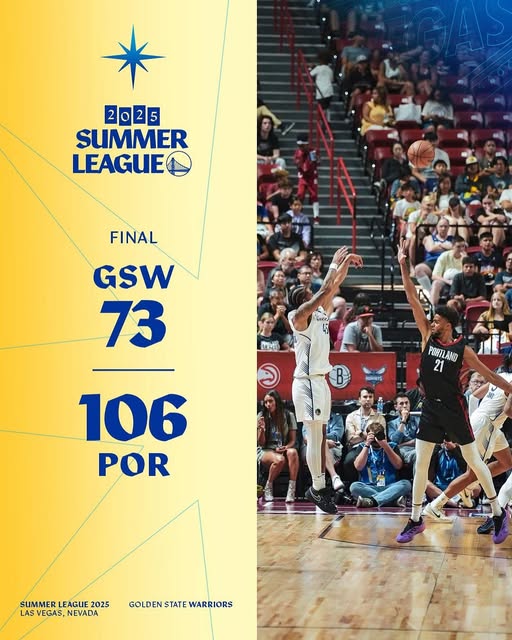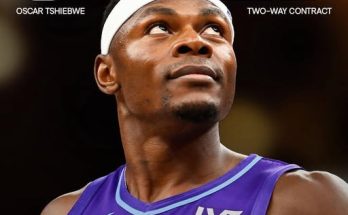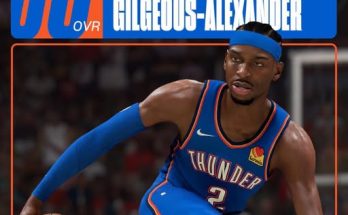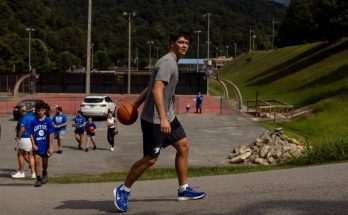The Golden State Warriors tipped off their 2025 Las Vegas Summer League campaign with a disappointing 86-79 loss to the Portland Trail Blazers in a contest that offered more questions than answers for a young squad trying to make its mark. While the Summer League is often a platform for raw talent and development rather than definitive conclusions, the Warriors’ opening performance reflected both promising flashes and concerning trends that could have ripple effects beyond the July exhibition slate.
From the opening tip, the Trail Blazers dictated the pace of the game, using length, physicality, and well-timed defensive rotations to disrupt Golden State’s flow. Despite the presence of a few familiar faces, such as Gui Santos and Lester Quinones, who had seen occasional NBA minutes last season, the Warriors struggled with cohesion. Portland’s roster, anchored by rookies with real upside and second-year players eager to prove they belong in a regular NBA rotation, looked better prepared for the moment. That edge showed in both execution and energy.
The Trail Blazers came out firing, especially from the perimeter. Early on, Portland’s backcourt established rhythm, knocking down contested jumpers and penetrating with confidence. Meanwhile, the Warriors appeared jittery. Their spacing was inconsistent, and they often fell into isolation-heavy sets that played into Portland’s switching defense. Turnovers became a recurring issue, with Golden State coughing the ball up 16 times, many of them unforced and coming at critical moments when momentum hung in the balance.
However, it wasn’t all bad for the Warriors. Gui Santos, continuing his upward trajectory from last summer’s strong showing, was one of the few consistent bright spots. He played with energy, displayed improved shot selection, and attacked the rim with purpose. His motor stood out on both ends, often being the first to loose balls or crashing the boards for second-chance opportunities. Santos finished with 18 points and 7 rebounds, showcasing the type of two-way effort that coaches crave in a developmental setting. Yet even his efforts couldn’t completely lift a team that often looked disconnected and reactive.
One of the biggest storylines entering the game was the debut of Warriors’ second-round pick Nadir Hill, a 6’5 guard out of Miami who drew comparisons to a younger Marcus Smart during pre-draft evaluations. Hill, known for his defensive prowess and physicality, had a mixed showing in his first game. While he did register three steals and had several possessions where he disrupted the Blazers’ offensive rhythm, his offensive contributions left much to be desired. He shot just 2-for-9 from the field, including several ill-advised jumpers early in the shot clock. It’s clear that Hill has the tools to be an impactful defender, but his offensive game remains a work in progress.
Offensively, the Warriors never found sustained rhythm. While they did make occasional runs — fueled by transition play and energy from bench players — their half-court sets lacked clarity. Too often, possessions ended in desperation heaves or stagnant one-on-one attempts that failed to generate open looks. Portland, by contrast, moved the ball crisply and seemed to trust their offensive system. The Blazers assisted on 20 of their 32 made field goals, a stark contrast to Golden State’s 13 assists on 28 makes. That disparity underscored the difference in team synergy and decision-making.
Perhaps the most telling indicator of the Warriors’ early issues came in the third quarter. Trailing by just three at halftime, Golden State looked poised to make a push, but instead came out flat. Portland ramped up its pressure, blitzed ball-handlers, and forced a series of rushed passes and contested shots. The result was a 12-2 run that gave the Blazers breathing room, and while the Warriors mounted a late charge in the fourth behind a couple of transition threes from Quinones and a putback slam by rookie forward Dorian Bailey, they never got closer than five points.
Bailey, the undrafted rookie out of Arizona State, was another player who turned heads in his Summer League debut. Though not particularly heralded coming out of college, Bailey showcased an intriguing mix of size, athleticism, and instinct. He finished with 11 points and 6 rebounds in 21 minutes off the bench, including a pair of explosive plays in transition. There’s rawness to his game, certainly, but also a spark that suggests he could be a candidate for a two-way contract if his upward trend continues over the next few games.
On the defensive end, the Warriors’ effort was inconsistent. There were flashes — stretches where they rotated well, closed out hard, and forced tough shots — but they lacked sustained discipline. Communication lapses led to several backdoor cuts and wide-open looks for Portland shooters, especially in the corners. The pick-and-roll coverage also left much to be desired. Portland repeatedly exploited drop coverages, with guards pulling up confidently or finding rollers for easy finishes at the rim. For a team that prides itself on defensive identity, even at the Summer League level, the lack of cohesion was noticeable.
Golden State’s coaching staff, led by Summer League head coach Anthony Vereen, emphasized postgame that the opener was a learning experience. “We’ve got guys who haven’t played together, who are still adjusting to NBA pace and physicality,” Vereen said. “There’s going to be growing pains. What matters is how we respond.” That sentiment is common in July basketball, where results are secondary to development, but it’s clear the staff will expect sharper execution going forward.
One area the Warriors must address immediately is their ball movement. The stagnant offense didn’t just hurt scoring efficiency — it also sapped energy from the team. Without the ball zipping around or multiple touches per possession, players tend to disengage, and defensive intensity wanes. When Golden State did move the ball with purpose, they generated quality looks, particularly from the wings. But those moments were too few and far between.
Rebounding also loomed large in the loss. Portland held a 42-34 edge on the glass, including a 13-8 advantage in offensive boards. Second-chance points proved crucial, especially as the Warriors’ initial defensive efforts occasionally held up. The inability to secure stops with a rebound allowed the Blazers to control tempo and demoralized a team trying to claw back. The hope is that with more time and perhaps tweaks to the rotation, Golden State can correct this issue.
Another subtle but important observation: the Warriors lacked a true floor general. Quinones played point guard for stretches, but he is more of a score-first guard, and it showed. There was no calming presence to settle the team, organize possessions, or control pace. The absence of a clear lead guard made their offense erratic, and unless someone steps up in that role or the team makes a short-term addition, it could continue to be a weakness throughout Summer League play.
Looking ahead, the Warriors will need to regroup quickly. Summer League schedules are compact, and there’s little time for prolonged struggles. The focus now turns to individual player development — can Santos continue building momentum and possibly earn a guaranteed deal? Can Hill become more comfortable offensively without losing his defensive edge? Will Bailey’s flashes turn into consistency? Those answers will determine the overall success of this trip to Vegas more than any win-loss record.
Ultimately, the loss to the Trail Blazers serves as a reminder of how delicate the developmental process is. The Warriors have intriguing pieces, but cohesion, confidence, and chemistry aren’t guaranteed — they must be cultivated through reps, film, and coaching. The team showed enough talent to believe in its upside, but also enough flaws to require honest self-assessment.
In Las Vegas, wins are nice, but growth is the real prize. If Golden State can extract lessons from this opener and channel them into better performances, the loss to Portland may prove to be a valuable starting point. But if the same issues persist — turnovers, poor spacing, rebounding lapses — this could be a long Summer League campaign for a franchise that needs its young talent to take meaningful steps forward.
For now, it’s back to the drawing board. The Warriors have work to do.



